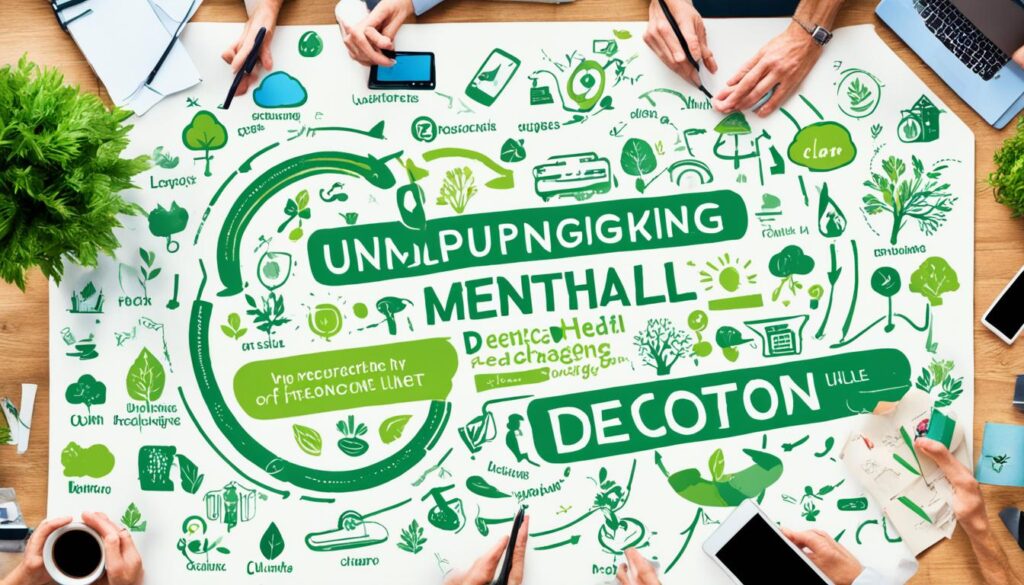An amazing 60% of people around the world feel hooked on their digital devices. This highlights the pressing need for a digital detox to regain and refresh our lives. Step by step, I’ll explain how taking a break from screens lets us recharge our minds. We can then control how much we use digital tech. This leads to improving our life quality.
Detoxing from digital devices is more than just spending less time on screens. It means choosing to stop the constant connection that harms our mental well-being. By choosing to disconnect now and then, we can see how important it is for our health. A break from technology changes not only how we spend our time but also how we live, work, and relate to others.
I urge you to discover the benefits and methods of digital detoxing. Moving forward, we’ll see how it lets us rediscover parts of ourselves lost to the digital world. Let’s explore how to achieve a balanced life, free from the endless demands of technology.
### Key Takeaways
- Recognise the high prevalence of digital device dependency and its impact on our lives.
- Grasp the significance of taking regular technology breaks for mental health rejuvenation.
- Appreciate digital detoxing as a transformative approach for reclaiming control over our daily lives.
- Identify strategies for effectively implementing a digital detox to achieve a balanced lifestyle.
- Understand the broader implications of constant connectivity on personal and professional wellbeing.
Understanding the Need for a Technology Break
In today’s fast-paced digital world, taking a technology break is crucial. Using digital gadgets too much adds to our screen time. This can hurt our mental health. It’s important to take breaks to feel balanced and healthy.
Spending too much time on screens can harm our minds. It can make us feel stressed, tired, and make it hard to socialise. So, it’s key to cut down on using digital devices.
Some people have found a good balance by taking technology breaks. Their experiences show us that using screens less is good for us. It’s a real-life example of why we should control our screen time.
- Improved concentration and productivity
- Enhanced interpersonal relationships
- Increased time spent on health-promoting activities like exercise and reading
But, it’s not just about what we do personally. There’s a big trend to take tech breaks in the workplace, too. Bosses are seeing that this helps their staff work better and be more creative.
| Aspect of Life | Impact of Uncontrolled Screen Time | Benefits of Technology Breaks |
|---|---|---|
| Work Productivity | Decreases due to multitasking and distractions | Increases as focus improves |
| Social Skills | Declines as virtual interactions replace face-to-face communication | Improves with more personal interactions |
| Physical Health | Adverse effects due to sedentariness | Enhances with more physical activity |
| Mental Well-being | Stress and anxiety levels rise | Better mental health from reduced screen exposure |
The table shows how important it is to take structured breaks from technology. With the digital world always changing, learning to take these breaks is key for our well-being. It helps keep our minds and bodies healthy.
The Impact of Constant Connectivity on Mental Health
In today’s digital age, we are always connected. This means we can be reached any time of day. The constant use of our devices might be affecting our mental wellbeing.
The Toll of Overstimulation
Constant notifications and updates can be overwhelming. This state of overstimulation can lead to stress and anxiety. It’s important to understand how this affects us to have a healthier relationship with technology.
Finding the Balance: Personal Stories
Some people have found a way to manage their constant use of technology. They have created rules around their devices and have seen improvements in their mental health. These personal accounts can guide us on how to reduce digital stress.
Societal Shifts: The Big Picture
Our digital habits are not just personal; they affect society as a whole. Everything now integrates with technology. Recognising this change can help us implement measures to protect our mental health.
While being constantly connected has its benefits, it also brings risks. It’s essential to find a balance and come together to find solutions for everyone.
Strategies for Initiating a Digital Detox
Starting a digital detox journey means taking specific steps to cut down on online time. It can seem hard to switch off, but with a plan, it gets easier and is worth it. Based on my own experiences, I can say these steps help you enjoy things away from screens.
The first big step is setting your detox goals. Maybe you want less screen time, fewer distractions, or better connections offline. Setting clear goals makes your detox focused and easy to keep track of.
- Establish Technology-Free Zones: Pick some places where gadgets aren’t allowed. This helps fight the urge to check them all the time.
- Schedule Offline Time: Choose certain hours or days to be tech-free. Use this time to do things that don’t need screens.
- Embrace Physical Activities: Swap screen time for physical exercise or time outside. This boosts your body and your mood.
| Strategy | Benefits |
|---|---|
| Technology-Free Zones | Reduces dependency on devices, improves personal interaction |
| Schedule Offline Time | Increases productivity and creativity, decreases stress levels |
| Embrace Physical Activities | Encourages a healthier lifestyle, enhances mood and energy levels |
Each of these strategies helps you cut back on digital use. This allows your mind and body to recharge. It’s key to see a digital detox not as one-off but something to include in a healthy daily plan. Unplugging helps you focus on the real world and enjoy the simple things offline.
As I started my digital detox, I noticed clearer thinking and better focus. It’s not about ditching tech but using it better.
By unplugging thoughtfully, we can improve our daily interactions. This boosts our life quality without depending too much on screens.
Digital Detoxing for Mindful Living
In the modern world, we’re always connected digitally. This can make living mindfully hard. However, taking a break, or a digital detox, is key to reconnect with who we are. It’s vital for those looking to enhance their awareness and lead a life filled with mindfulness.
Connecting with Your Inner Self
Stepping away from our screens does wonders for our inner self. Without the buzz of messages and alerts, we get to think deeply. This is essential for growing personally and seeing life in a more meaningful way. It’s about going beyond just being, to truly experiencing life.
Mindfulness in the Age of Distraction
The world is full of distractions, making mindfulness more important than ever. With practices like meditation, we can focus and find clarity. This helps us enjoy uncomplicated times in nature or quiet moments more. It’s not just about being happy now but also feeling good in the long run.
| Activity | Benefits |
|---|---|
| Meditation | Increases self-awareness, reduces stress, promotes emotional health |
| Mindful Walking | Enhances physical fitness, improves mood, connects you to nature |
| Digital Fasting | Reduces anxiety, improves sleep, fosters real-world relationships |
Detoxing from digital life helps us reset our tech relationships. It also deepens our mindful living commitment. By avoiding distractions, we open doors to a more focused, reflective life. This way, we cherish every moment with great enthusiasm.
Turning Off to Tune In: Screen Time Reduction
In my journey towards a healthier life, reducing screen time has been key. It’s more than just cutting hours. It’s about finding a good balance between tech use and real-life fun. I’ll share tips and tricks to help anyone find this balance.
First, I checked how long I was using my devices. I was surprised to find that I spent a lot of time on things that didn’t really help me grow. Then, I started to take back my time from my devices.
- I now check emails and social media at certain times, not all the time.
- I stopped scrolling aimlessly. Now, I spend my time online wisely, looking for useful info or fun.
- I also have regular days without any non-essential digital use, my digital detox days.
These changes have really worked. My screen time has gone down, and I feel clearer in my mind. I’m also more productive. Now, I exercise more, read books, and do creative stuff. These things got neglected when I was on my devices too much.
| Activity | Time Spent Before | Time Spent After |
|---|---|---|
| Social Media | 3 hours | 1 hour |
| Emails | 2 hours | 1 hour |
| Entertainment | 2 hours | 30 minutes |
Every little step I take to reduce screen time really changes how I use technology. It’s no longer just a distraction. It helps me grow and be well. Making these changes has really balanced my life. Now, technology helps me instead of getting in the way.
Creating a Device-Free Environment at Home
In today’s world, we’re often glued to our screens. Making our homes free from devices can boost our happiness and how we connect with others. By setting rules for gadget use and spending time offline, we can turn our homes into peaceful places.
Setting Boundaries with Gadgets
It’s key to set clear rules about using devices at home. This might mean no gadgets at the dinner table or in the bedroom. Also, not using devices during meals or before bed has big benefits. This helps make our times together and our sleep better.
Engaging in Offline Activities
Doing things away from screens can make us feel better. Activities like painting, gardening, and exercising are great. Spending real time with family and friends is also very important. These things make our lives fuller, more meaningful than just using gadgets.
| Activity | Benefits | Time Spent Weekly |
|---|---|---|
| Gardening | Stress reduction, physical health | 3 hours |
| Board Games | Cognitive skills, family bonding | 2 hours |
| Reading | Mental stimulation, knowledge gain | 4 hours |
Reaping the Benefits of an Internet Hiatus
Taking a break from the internet can change our lives for the better. It boosts our mood, helps us work better, and makes us more creative. It also helps us build stronger relationships.
One big change is in our mental health. When we’re not online, we feel less stressed and can relax. This is really important today, where we’re always busy and on the go.
Without online distractions, I get more done. I focus better and finish my work faster.
Stopping the online world for a bit can do wonders for our creativity. It gives our minds the quiet they need to come up with new ideas. When we’re not online, we think more outside the box.
Our social life benefits a lot from this break too. Talking in person helps us connect better with people. I’ve noticed that without our devices, conversations are deeper and more fun.
| Aspect of Life | Impact of Internet Hiatus |
|---|---|
| Mental Well-being | Marks a decrease in stress and anxiety levels |
| Productivity | Enhances ability to concentrate and complete tasks efficiently |
| Creativity | Encourages the generation of innovative ideas and solutions |
| Interpersonal Relationships | Strengthens bonds through uninterrupted, meaningful interactions |
In summary, taking a break from the internet makes our lives better in many ways. It’s not just about feeling happier. It helps us work smarter, be more creative, and get closer to the people around us.
Tips for Maintaining Balance Post-Digital Detox
After a digital detox, balance is key for long-term benefits. It’s important to avoid the quick urge to reconnect. Having a plan is vital to enjoy the benefits of a digital detox while using technology wisely.
Resisting the Urge to Reconnect Prematurely
Jumping back into daily digital demands post-detox can be tempting. However, it’s important to re-engage slowly. This approach ensures you keep the peace you found during the detox. Here’s what you can do:
- Think about the good changes you noticed, like better sleep or focus, daily.
- Start with checking devices at set times. Increase these slowly to maintain well-being.
- Enjoy non-tech activities such as reading, hiking, or cooking to limit the urge to reconnect.
Long-Term Strategies for Device Management
Long-term balance requires solid device management plans. These help keep the offline benefits while using tech wisely. Here are some strategies to try out:
- Create a tech policy for yourself. Deciding when and where to use technology is key.
- Make certain areas at home tech-free to boost personal connections and relaxation.
- Be mindful of technological use, ensuring each usage has a clear purpose.
Regular use of these long-term strategies can help you manage technology better. They also lift the quality of your daily life. Finding balance post-detox isn’t just about less screen time. It’s about forming healthier habits with technology.
Conclusion
Digital detoxing is vital for a well-rounded life. It can boost our mental and emotional health in many ways. By stepping away from our screens, we lower stress and improve our relationships.
We need to make some major changes to be less glued to our devices. Setting up spaces without technology and enjoying offline hobbies help a lot. These steps guide us towards living in harmony, managing tech use and our social and personal needs.
Starting your digital detox journey is important, and it’s a never-ending process. Cutting down on screen time for good changes your life. We should always choose what’s best for our happiness and health.






